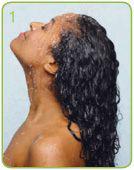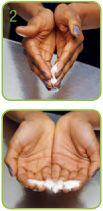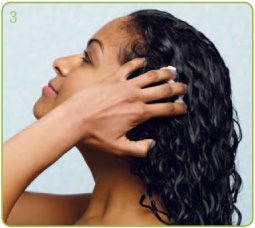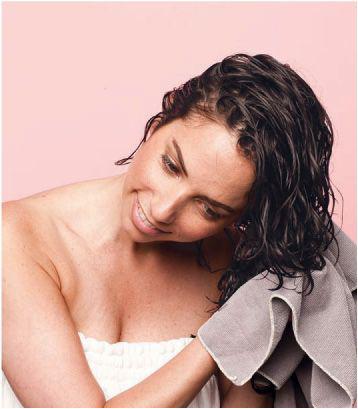B003YL4KS0 EBOK (10 page)
Authors: Lorraine Massey,Michele Bender

THE BASIC FOR ALL TYPES OF CURLSWhatever your type of curls, follow the general directions for cleansing, conditioning, scrunching, and styling your hair on the following spread. Also toss out your hairbrushes and combs, even those that claim to be made for curls. The act of brushing or combing the hair actually interferes with your curls’ formation and causes breakage and dispersed curls—otherwise known as frizz! Instead, use your fingers to comb through the hair only when it’s wet and drenched with conditioner in the shower. This way you respect each fragile curl’s natural placement, and the hair is more fluid.
CleansingThere are two parts to the cleansing routine for all curls: cleansing your scalp and hair and then conditioning your hair. How often you cleanse and condition depends on your hair and where you are in the process. If you’re weaning yourself off shampoo, you may want to stay on your usual cleansing schedule, just replacing your regular shampoo with a sulfate-free product or a botanical conditioner. You might not like a bubble-free diet, but your hair will love it. Once your hair becomes more hydrated and healthy, you will probably cleanse less often and just wet your hair and go right to the conditioning step for your curl type. It’s also important to allow the hair to rest at times and not get locked into a scheduled routine of overcleansing. I know wavy types who only wash their hair every three to four days.
If you are new to this curly girl approach to hair care, the amounts of product you use will change as your hair becomes healthier. For example, early on you may need to use lots of conditioner because your hair is dry and thirsty, then, as your hair gets hydrated, you’ll use less. Because your curls’ moods are so affected by weather and climate, you may have to adjust the amount of product you use when you travel or as the seasons change.
Generally, the tighter or drier the curl, the more botanical conditioner you need. Hair that’s been damaged by blow-frying, coloring, or chemical straightening absorbs conditioner quickly and needs more. Experiment with different amounts to figure out what’s best for your hair, but err on the side of more conditioner rather than less.
ConditioningFor most curl types, I suggest leaving some or all of your conditioner in your hair. I know this sounds unorthodox, especially since we’re so conditioned—ahem!—to rinsing thoroughly for fear that product will weigh our hair down. But curly hair needs that extra moisture to stay hydrated and frizz-free, and the word greasy is almost never relevant to a curly girl. Others worry that leaving conditioner in will make your hair crunchy or sticky, but that won’t happen with the right product (see
chapter 8
,
page 79
, for choosing a conditioner). In fact, a favorite trick of girls with a high frizz factor and dense, thick curls is to not rinse out any conditioner at all. Why? Because when you squeeze out excess water with a paper towel or microfiber towel (see photo, right), it’s like rinsing—the hair naturally absorbs the conditioner it needs to stay hydrated and releases what it doesn’t.In the conditioning sections for each type of curl, I suggest gliding conditioner downward through your hair with your fingers. If you have longer hair, follow this step by scrunching the same section of hair upward toward the scalp. This opposite motion will encourage and reintroduce your intrinsic curl pattern to your hair.
I often use the words “squeeze-quench” to describe the process of squeezing hair with conditioner in an upward motion toward the scalp. It usually releases a milky residue of excess water and conditioner. A squishy sound and hair that feels as viscous as wet seaweed means that “hydration penetration” has been accomplished.
A generous palmful of conditioner gives curls frizz-fighting hydration.
ScrunchingNever dry curls with a conventional towel, because it will absorb too much moisture and its harsh fabric will ruffle the sensitive hair cuticle, causing frizz. Instead, I suggest using a paper towel, an old cotton T-shirt, or a microfiber towel. Though I mention these three options throughout the book, you can use anything smooth and absorbent, like a pillowcase or baby’s burp cloth. Gently rotate the fabric as you blot the hair. Just like blotting a sweater in a towel after washing, precious hair fibers need the same gentle care. “Scrunch-squeeze” is how I describe the upward scrunching motion toward the scalp that you make with a microfiber towel to absorb extra moisture.
Use a paper towel, an old cotton T-shirt, or a microfiber towel to absorb moisture from curly locks.
StylingGel is an important part of every curly girl’s routine because it gives definitive hold but is light to the touch. As your hair begins to dry and the gel hardens, don’t be alarmed by the crystallized curl cast, or “gel cast.” This helps hold the natural curl formation until the hair dries, protecting it from outside elements like wind and humidity. Once hair is completely dry, you can dissolve and release the gel cast by tilting your head forward and gently scrunching hair upward toward the scalp. The result will be soft, defined, touchable curls. It’s important to use a gel that’s alcohol-and silicone-free, as it lives in your hair for 2 to 3 days.
A half palmful of gel helps hold your curls’natural shape.
Note:
For each type of curl in the book, I give an approximate time for how long it will take to cleanse and style. This period will get shorter as hair gets healthier and more hydrated.Simply being curly is not enough. Beautiful, healthy hair is the result of first accepting your curls for their natural tendencies, then working with them, and being really consistent in your daily care routine. Remember, you are the custodian of that little garden atop your head! It will reflect the care that you give it.
•
Total cleansing/conditioning and styling time: 10 to 15 minutes, depending on the length of the hair.
Daily Routines: Botticelli, Corkscrew, and Corkicelli Curls (3:36)
1
Step under the shower as if you’re standing under a waterfall and let the water cascade through your curls. Resist the impulse to start scrubbing your head and disturbing your hair’s basic shape. If the water pressure is strong, cup your hair in your hands. Wet hair thoroughly.

2
Cup one hand, take a sulfate-free cleanser or botanical conditioner, and apply it in a straight line along your fingertips the way you’d apply toothpaste to a toothbrush. Evenly distribute to the fingertips of the other hand and then apply directly to the scalp; be careful not to disturb your curls.

Distribute cleanser evenly on fingertips.
3
Starting at the temples, massage the scalp with circular motions, move down the sides and then to the top of your head and crown. Finally, move down the back of your head, finishing up at the nape. Now let the water spray through your hair, rinsing out whatever your fingers have loosened. When you rinse the top of your hair, the ends of the hair will get clean as the cleanser or conditioner moves downward. This method will create fewer tangles and will prevent overwashing the typically drier, more mature ends of your hair.





